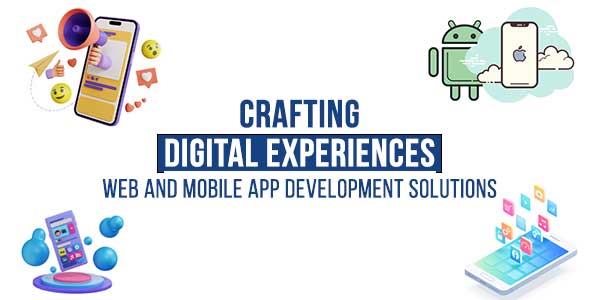
In the rapidly evolving digital landscape, crafting exceptional digital experiences is paramount for businesses aiming to stay competitive and meet the ever-growing expectations of users. Web and mobile app development have emerged as pivotal avenues for businesses to engage, serve, and delight their audience. This comprehensive guide delves into the intricacies of crafting digital experiences through web and mobile app development, exploring the key considerations, trends, and solutions that define the landscape in 2024.
Table of Contents
Understanding The Digital Experience Landscape:
User-Centric Approach:
Crafting a digital experience begins with a user-centric approach. Understanding user behavior, preferences, and pain points is fundamental to developing solutions that resonate with the target audience.
Responsive Web Design:
In the era of diverse devices and screen sizes, responsive web design is crucial. Ensuring that web applications adapt seamlessly to various devices enhances accessibility and user satisfaction.
Mobile-First Development:
With the proliferation of mobile devices, adopting a mobile-first development strategy is essential. Prioritizing the mobile experience ensures that applications are optimized for the devices users most frequently interact with.
Intuitive User Interface (UI):
A well-crafted user interface is the gateway to a positive digital experience. Intuitive navigation, visually appealing design, and clear calls-to-action contribute to a seamless and enjoyable user journey.
Personalization:
Tailoring digital experiences based on user preferences fosters a sense of personalization. From personalized content recommendations to adaptive interfaces, customization enhances user engagement.
Web App Development Solutions:
React.js:
js, a JavaScript library developed by Facebook, is renowned for building dynamic and responsive user interfaces. Its component-based architecture and virtual DOM make it a popular choice for crafting engaging web applications.
Angular:
Developed by Google, Angular is a comprehensive web application framework that excels in building complex and feature-rich applications. Its two-way data binding and modular architecture contribute to efficient web development.
Vue.js:
js is a progressive JavaScript framework that prioritizes simplicity and flexibility. Its incremental adoption allows developers to integrate Vue.js into existing projects, making it versatile for various web development scenarios.
Next.js:
js is a React framework that simplifies the process of building static and dynamic web applications. With features like server-side rendering and automatic code splitting, Next.js enhances performance and developer productivity.
Django:
Django, a high-level Python web framework, is renowned for its simplicity and robustness. With built-in features like an Object-Relational Mapping (ORM) system and an admin interface, Django accelerates the development of secure and scalable web applications.
Mobile App Development Solutions:
Flutter:
Its expressive and flexible UI components make it a powerful choice for crafting visually appealing mobile apps.
React Native:
Leveraging the power of React.js, React Native enables developers to build cross-platform mobile applications using a single codebase. Its component-based architecture and hot-reloading feature expedite development cycles.
Swift (iOS):
For iOS app development, Swift has emerged as the go-to programming language. With a focus on speed and safety, Swift enables developers to create high-performance and reliable mobile applications for the Apple ecosystem.
Kotlin (Android):
Kotlin, endorsed by Google as the official language for Android development, offers conciseness and interoperability with Java. It enhances developer productivity and brings modern language features to Android app development.
Xamarin:
Xamarin allows developers to build cross-platform mobile applications using C# and the .NET framework. With shared code logic, Xamarin streamlines development for both iOS and Android platforms.
Emerging Trends Shaping Digital Experiences:
Progressive Web Apps (PWAs):
PWAs combine the best of web and mobile app experiences, delivering fast and reliable performance. They offer offline capabilities, push notifications, and a native app-like feel, enhancing user engagement.
Voice User Interface (VUI):
With the rise of virtual assistants and smart speakers, integrating Voice User Interfaces into web and mobile apps is gaining prominence. VUI enhances accessibility and provides a hands-free interaction experience.
Augmented Reality (AR) and Virtual Reality (VR):
AR and VR technologies are reshaping digital experiences by immersing users in virtual environments. From interactive product experiences to virtual tours, AR and VR enhance engagement and storytelling.
Artificial Intelligence (AI) and Machine Learning (ML):
AI and ML are powering intelligent features such as personalized recommendations, chatbots, and predictive analytics. These technologies elevate digital experiences by adapting to user behavior and preferences.
Blockchain Integration:
Blockchain is making inroads into enhancing security and transparency in digital transactions. Integrating blockchain into apps can ensure secure and verifiable data transactions, especially in finance and e-commerce.
Challenges And Considerations In Crafting Digital Experiences:
Data Privacy and Security:
With an increasing focus on data privacy, ensuring robust security measures is paramount. Compliance with data protection regulations and implementing secure coding practices are essential considerations.
Cross-Browser and Cross-Device Compatibility:
Achieving consistency across various browsers and devices is a challenge. Testing and optimizing digital experiences for diverse environments are crucial for broad accessibility.
Performance Optimization:
Users expect fast-loading and responsive applications. Performance optimization, including image compression, code splitting, and efficient caching strategies, is vital for a seamless user experience.
Scalability:
As user bases grow, ensuring scalability becomes critical. Architecture design and cloud-based solutions can address scalability challenges and support growing user demands.
Accessibility:
Crafting inclusive digital experiences requires attention to accessibility standards. Implementing features like alt text for images and keyboard navigation ensures a wider audience can interact with the application.

Web And Mobile App Development Solutions Strategy:
Crafting an effective strategy for web and mobile app development solutions is crucial for businesses aiming to deliver seamless, user-centric experiences. The strategy involves a combination of careful planning, technology selection, and a commitment to staying abreast of emerging trends. Here’s a comprehensive strategy to guide the development of impactful web and mobile applications:
1.) Define Clear Objectives:
- Web Application Goals: Clearly articulate the purpose of the web application. Define whether it’s an informational site, an e-commerce platform, or an interactive web application.
- Mobile App Objectives: Specify the goals of the mobile app, such as enhancing user engagement, providing specific functionalities, or expanding brand reach.
2.) Understand The Target Audience:
- User Persona Development: Create detailed user personas to understand the demographics, behaviors, and preferences of the target audience for both web and mobile platforms.
- User Journey Mapping: Map out the user journey, identifying touchpoints and interactions with the applications. This helps in designing a user-centric experience.
3.) Choose Appropriate Technologies:
- Web App Development Technologies: Select the appropriate web development frameworks based on the project’s complexity and requirements. Consider factors such as React.js, Angular, or Vue.js for front-end development and Django or Node.js for back-end development.
- Mobile App Development Platforms: Choose between native, cross-platform, or hybrid development based on factors like target audience, budget, and required features. Popular choices include Flutter, React Native, Swift (for iOS), and Kotlin (for Android).
4.) Embrace Responsive Design:
- Ensure that both web and mobile applications adopt responsive design principles. This guarantees a consistent and user-friendly experience across a variety of devices and screen sizes.
5.) Prioritize User Interface (UI) And User Experience (UX):
- Intuitive Design: Design user interfaces that are intuitive and easy to navigate. Prioritize a clean and visually appealing design that aligns with the brand’s identity.
- User Feedback Integration: Incorporate user feedback loops during development to iteratively improve UI/UX based on real user experiences.
6.) Implement Security Measures:
- Web App Security: Implement secure coding practices, employ HTTPS, and conduct regular security audits to protect against potential vulnerabilities.
- Mobile App Security: Apply encryption for data transmission, secure user authentication, and regularly update the app to patch security loopholes.
7.) Leverage Cloud Services:
- Utilize cloud services for scalable and flexible infrastructure. Cloud platforms like AWS, Azure, or Google Cloud provide robust solutions for hosting, storage, and application scaling.
8.) Follow Agile Development Methodology:
- Adopt an agile development approach for both web and mobile app projects. Break down development into sprints, allowing for flexibility, adaptability to changes, and faster delivery of increments.
9.) Integrate Emerging Technologies:
- Progressive Web Apps (PWAs): Consider implementing PWAs to combine the best features of web and mobile apps, providing a fast and reliable user experience.
- Voice User Interface (VUI): Explore integrating voice-controlled functionalities for enhanced accessibility and user engagement.
- Augmented Reality (AR) and Virtual Reality (VR): Assess the feasibility of incorporating AR or VR features to create immersive experiences, especially in industries like education, retail, or real estate.
10.) Conduct Thorough Testing:
- Implement rigorous testing procedures for both web and mobile applications. Perform functional, usability, security, and performance testing to identify and resolve any issues before deployment.
11.) Ensure Cross-Platform Compatibility:
- Optimize the applications for cross-platform compatibility. Test thoroughly on various browsers and devices to ensure a consistent experience for all users.
12.) User Acquisition and Marketing:
- Develop a marketing strategy to promote the web and mobile applications. Utilize digital marketing channels, social media, and app store optimization (ASO) to drive user acquisition.
13.) Continuous Improvement and Updates:
- Regularly gather user feedback post-launch and use it to inform updates and improvements. Embrace a continuous improvement mindset to stay competitive in the evolving digital landscape.
14.) Monitor Analytics and Performance:
- Implement analytics tools to monitor user behavior, track performance metrics, and gain insights into how users interact with the applications. Use this data to make informed decisions for ongoing optimization.
15.) Plan for Scalability:
- Develop applications with scalability in mind. Anticipate growth and ensure that the architecture and infrastructure can handle increased user loads without compromising performance.
16.) Data Privacy and Compliance:
- Prioritize data privacy by implementing secure data storage practices. Ensure compliance with relevant data protection regulations, such as GDPR or HIPAA, depending on the nature of the application.
17.) User Support and Maintenance:
- Establish a support system for users to address queries and issues promptly. Implement a maintenance plan for regular updates, bug fixes, and feature enhancements.
18.) Stay Informed About Trends:
- Keep abreast of evolving technologies and trends in web and mobile app development. Embrace innovations that align with the business goals to maintain a competitive edge.
By integrating these strategic considerations, businesses can navigate the complexities of web and mobile app development with a holistic approach, ensuring the creation of digital solutions that not only meet but exceed user expectations.
Future Outlook: Navigating The Evolving Landscape:
The future of crafting digital experiences lies in a continued focus on user-centric design, emerging technologies, and seamless integration across platforms. As the digital landscape evolves, businesses will need to adapt and leverage innovative solutions to meet the expectations of a tech-savvy audience. From immersive technologies like AR and VR to the continued evolution of AI and ML, the possibilities for crafting exceptional digital experiences are vast. Success in this landscape requires a strategic blend of creativity, technology adoption, and a relentless commitment to delivering value to users in every interaction.

 About the Author:
About the Author:
















Be the first to write a comment.